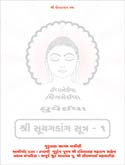SHREE SUYAGADANG SUTRA
This is the second Aṅga Sutra. It has two main parts and 23 chapters.
- In the first chapter after giving in-depth description of the beliefs of other religions, the excellence of Jainism is shown. Ways in which bondage and liberation of the soul takes place is also explained.
- The second chapter has the story of how Bhagwan Rishabhdev advises his 98 sons to understand the power of their souls and the eternal bliss they would experience on conquering their own souls.
- The third chapter shows the different adversities and troubles that could be faced by aspiring ascetics (Sadhaks) while following the path of liberation and tips are given on how to maintain their mental stability while facing them.
- The forth chapter explains how contact and friendship with females, due to their nature can lead to the downfall of a Monk (Sadhu). Hence they are advised to abstain from coming in close contact with females.
- The fifth chapter explains in detail the miseries that a soul undergoes in Hell.
- Sixth chapter is an eulogy (Stuti) of Bhagwan Mahavir.
- Seventh chapter explains the good & bad characters of an ascetic by giving different examples and they are advised to refrain from poor conduct.
- Eighth chapter explains how soul energy canbecome the reason of bondage or liberation of the soul.
- Ninth chapter gives an extra-ordinary explanation and importance of knowledge and conduct in religion.
- Tenth chapter shows how by keeping the mind calm and stable, the soul can experience bliss and in turn find ways of becoming enlightened.
- Eleventh chapter emphasizes the necessity of Enlightened Perception (Darshan), Enlightened Knowledge and Enlightened Conduct for the Soul to attain emancipation.
- Twelfth chapter gives the description of one dimensional beliefs of:
- people who believe only in rituals and
- people who do not believe in rituals but only in intentions,
- people who believe veneration only and
- people who are ignorant
It is recommended to accept them in terms of relativity of their situation.
- Thirteenth chapter gives an in-depth description of the qualities (knowledge, conduct etc) of an ascetic and the different types of ascetics on improper path.
- Fourteenth chapter emphasizes the importance of “Guru-Shishya parampara” (teacher-student tradition) and recommends an aspiring ascetic to stay in refuge of his Guru for destroying the bondage of karmas.
- Fifteenth chapter shows the importance of indifference, understanding of the impermanent nature of matter etc. in the form of 12 inclinations which a soul can have to attain emancipation and the 4 inclinations like friendship etc. of a soul.
- Sixteenth chapter gives an inspirational explanation of the words Shraman (Jain Monk), Mahan (Jain mendicant), Bhikshu (one who begs and eats) and Nirgranth (unfurl the knots of karmas that bond the soul) which have the same meaning and are like synonyms.
- Seventeenth chapter describes the true nature of an ascetic who is indifferent to worldly pleasures using Lotus metaphorically.
- Eighteenth chapter contains explanation on the 13 avenues of performing deeds (kriya).
- Nineteenth chapter gives an explanation of the type of food eaten by all living beings at the time of their birth.
- Twentieth chapter explains the importance and benefits gained by person on taking oath before performing penance of any kind against no benefits gained by a person not taking oath before performing penance.
- Chapter Twenty-one explains the conduct and misconducts of an ascetic.
- Chapter Twenty-two contains the interaction done by Ardrak Muni with religious heads of other religions.
- Chapter Twenty-three contains the discussions between Gautam Swami and Ascetic Pedhal Putra who is an ardent follower of Bhagwan Parshwanath.
This is how by studying the inclination and thoughts process of other religions one can understand difference between them and the Jain religion. Thereby any individual can logically come to know how the Jain religion thinks a step further for the emancipation of the soul. This the specialty of Shree Suyagadang Sutra aagam.
| 


